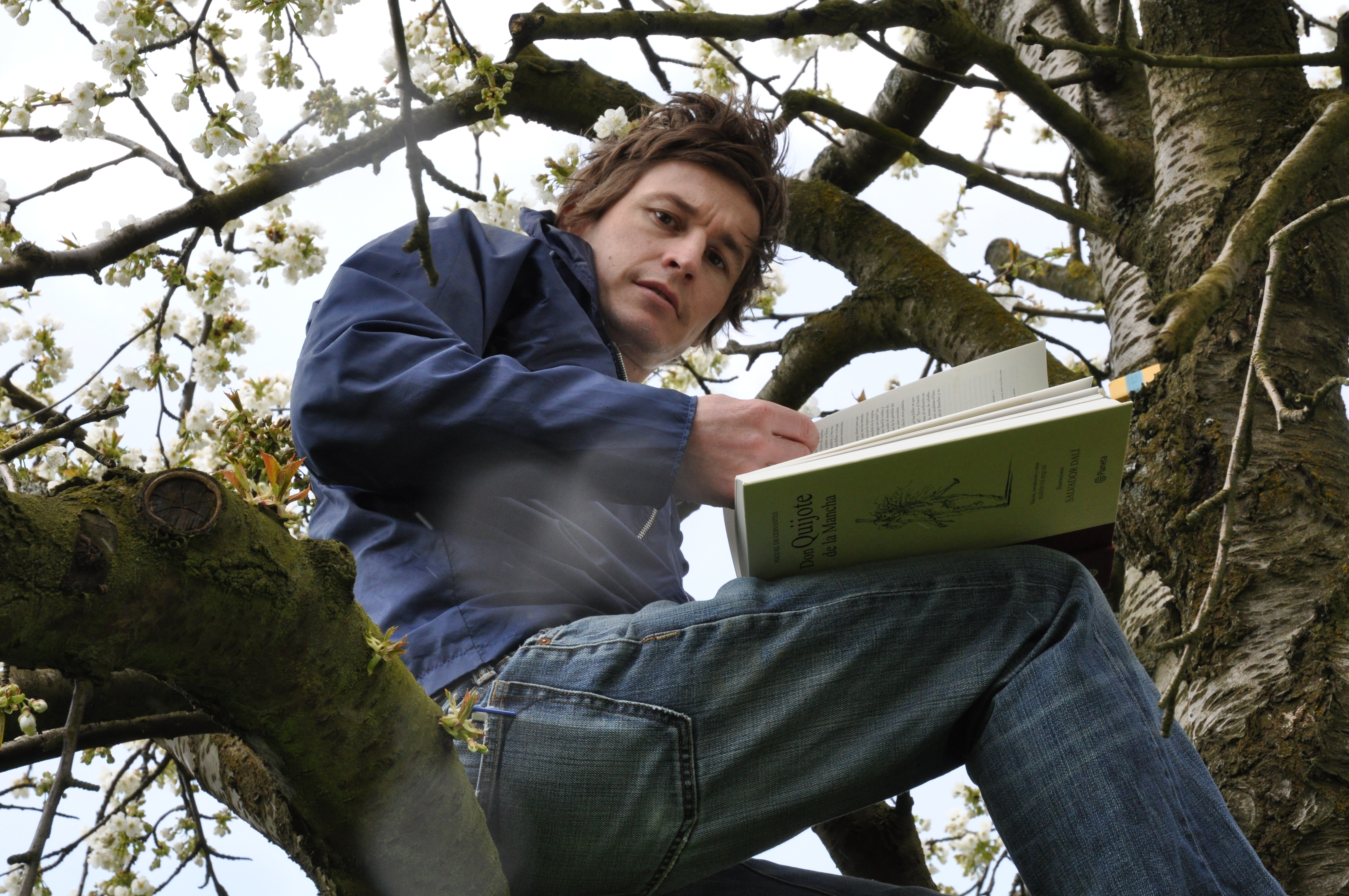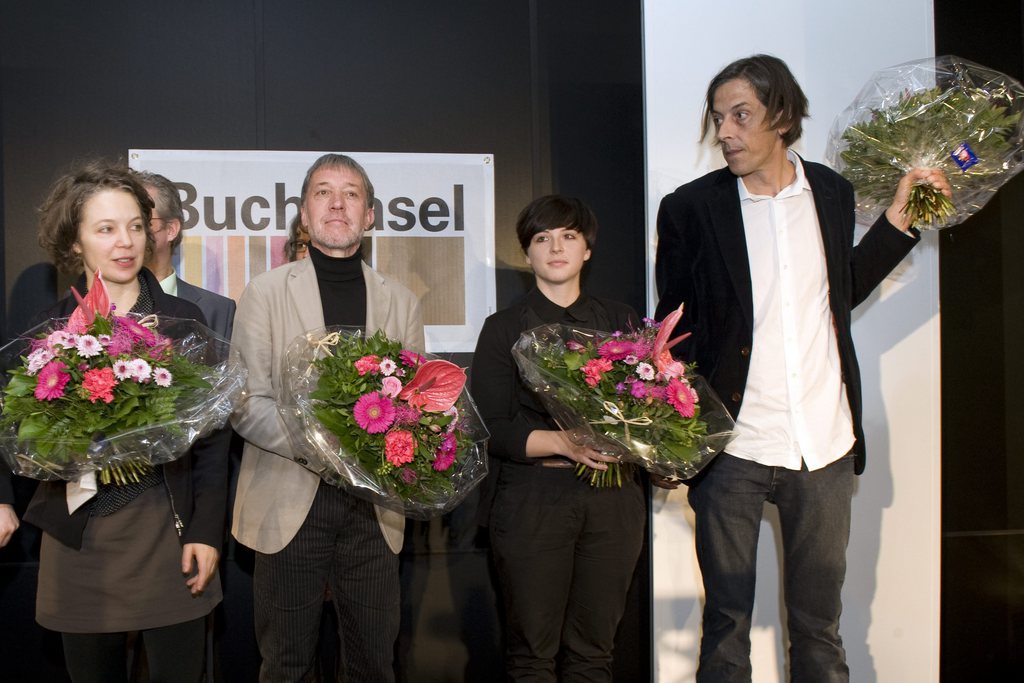Welcome to the literary Babel belt

Award-winning Swiss author Arno Camenisch writes in German – but peppers his sentences with Swiss-German, Italian and Romansh words and expressions. Despite this linguistic fusion, he insists his characters have a universal appeal.
In Hinter dem Bahnhof (Behind the Station), a child describes a series of events in a Graubünden mountain village which is far from the usual chocolate-box image of alpine luxury.
We don’t know the name of the village. We do, however, know that it contains “13 cats, six dogs, four fire hydrants” and 40 or so inhabitants. The city-dwellers call them “mountain morons” , but they couldn’t care less – their kindness overcomes any adversity.
There’s something tender and monstrous about this village, populated by extraordinary people such as Tini Blutt, an exhibitionist of undefined gender.
Or the narrator’s grandfather, with his “seven-and-a-half fingers – five on the left hand and just a thumb, index finger and half a middle finger on the right”. He’s been maimed, like other characters in Camenisch’s work, for example Sez Ner, the first volume in the “Graubünden trilogy”.
“Unique”
Camenisch himself is also extraordinary. In Switzerland he is unique – not because of the subjects he addresses, but because of the way he tells them.
German, Swiss-German, Italian and Romansh merge and influence each other and result in an original language. A lot of the spelling is as twisted as the characters, with The Helvezia eaterie, for example, referred to as a “restorant”.
What’s more, in addition to the four languages already mentioned, Behind the Station has also been translated into Switzerland’s other national language, French.
The unenviable task of translating what might appear to be untranslatable fell to 25-year-old Camille Luscher, who leapt across the Röstigraben, the linguistic divide that separates the fried potato-eating German-speakers from those who speak French.
“I certainly did,” she smiles. “Although the language I use is artificial, it reflects a certain cohesion. I wanted above all to hear Romansh in the French – to make it jump across the Graubünden border.”
According to Luscher, in the French-speaking part of Switzerland many expressions have been “contaminated” by German but have not really been touched by Italian or Romansh.
Universal appeal
One might think linguistic regionalism and life in an alpine village would make Behind the Station somewhat inaccessible – especially for a foreign audience. Camenisch disagrees. He says the story features characters found everywhere: an ironmonger, a milkman, a poet, a mechanic, a doctor…
His success abroad strengthens his argument. Sez Ner, for example, has been translated into English, French, Hungarian, Dutch, Romanian and Bulgarian.
This has drawn him to the attention of Dalkey Archive Press, a large publishing house in the United States, which has bought the rights to the trilogy and will publish Sez Ner, Behind the Station and Ustrinkata in 2013, 2014 and 2015 respectively.
Camenisch is currently preparing to give a reading in New York of Ustrinkata (just published in German), as he also has done around the world with the previous two books.
“Language barriers don’t exist!” he says, insisting on the universality of his work.
“In Germany, in Hungary, people came up to me after the reading of Behind the Station. One woman told me, ‘that road you described – it’s my road. I recognised my neighbours in your characters’.”
Lost in translation?
Nevertheless, it’s hard to imagine how it’s possible to translate such rich and vivid language into English, for example. Doesn’t Behind the Station risk losing its essence and character?
Camille Luscher doesn’t think so. “Each translator adapts the story into the target language. The English-language translator lives in Scotland and wants to use the English that’s spoken in rural Scotland.”
Donal McLaughlin, the translator in question who is also the English-language voice of Swiss authors Urs Widmer and Pedro Lenz, explained at the Solothurn Literature Festival in May what attracted him to Camenisch.
“He tells stories so wonderfully; he works so wonderfully with language. It’s all so rhythmic, musical and fun – it’s simply life!”
Turning the trilogy into a sort of drug-free Trainspotting up a mountain – Irvine Welsh’s 1993 bestseller was written in Scots, Scottish English and British English – is a neat way of exporting Swiss expressions, although this surprises Camenisch.
“Swiss expressions? It’s only the Swiss who think the story is typically Swiss.”
Born in Graubünden in 1978, Arno Camenisch writes in both Romansh and German.
He is best known for his award-winning novels, Sez Ner (2009) and Hinter dem Bahnhof (2010) – the first two parts of a trilogy. The final part, Ustrinkata, deals with the final days of a village café.
Camenisch is a graduate of the Swiss Literature Institute in Biel. He has also published poetry in literary magazines and anthologies.
In 2010, he was awarded both the ZKB Schiller Prize and the Bernese Literature Prize for Sez Ner.
(Adapted from French by Thomas Stephens)

In compliance with the JTI standards
More: SWI swissinfo.ch certified by the Journalism Trust Initiative












You can find an overview of ongoing debates with our journalists here . Please join us!
If you want to start a conversation about a topic raised in this article or want to report factual errors, email us at english@swissinfo.ch.